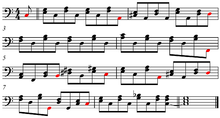Talk:Stomp progression
| This is the talk page for discussing improvements to the Stomp progression article. This is not a forum for general discussion of the article's subject. |
Article policies
|
| Find sources: Google (books · news · scholar · free images · WP refs) · FENS · JSTOR · TWL |
| This article is rated Start-class on Wikipedia's content assessment scale. It is of interest to the following WikiProjects: | |||||||||||||||||||||
| |||||||||||||||||||||
Chords
[edit]But what IS it? The "50s progresson" is defined as I-vi-IV-V. How is this "stomp progression" defined? --63.25.230.125 (talk) 11:57, 14 July 2008 (UTC)
Jackson 5 "I Want You Back"
[edit]The main chord motif in Jackson 5's "I Want You Back" sounds a lot like this progression. But of course I can't find a source that says so PenguiN42 (talk) 00:30, 11 September 2009 (UTC)
What is the Stomp progression?
[edit]
The chords given in this article, obviously done in good faith, correspond to the A section of "King Porter Stomp." However, upon reading the article given as a reference, it appears that what musicologists refer to as the "stomp progression" is the progression of the "stomp" section, the riff section at the end of the song. This is the progression that appears in "Slipped Disc," "Jump Town," "At the Clambake Carnival" and "Bojangles," while similar progressions appear in "Study in Brown" and "Well, git it!" There is definitely no appearance of the A section progression from "King Porter Stomp" in those songs.
Here is the "Stomp progression":
ǁ: IV7 #ivo7 | I7/5 V7/IV | IV7 #iv°7 | I7/5 V7/IV | IV7 #iv°7 | I7/5 V7/II | V7/V | V7 V7/IV :ǁ
In the original key of A♭:
ǁ: G♭7 G°7 | D♭7/A♭ D♭7 | G♭7 G°7 | D♭7/A♭ D♭7 | G♭7 G°7 | D♭7/A♭ B♭7 | E♭7 | A♭7 D♭7 :ǁ
Could someone else please clarify that this is what is meant by "stomp progression" in the article? If nobody cares then I will just change it. BassHistory (talk) 09:31, 19 December 2010 (UTC)
Add "Hyena Stomp" to the list, probably the most clear example. "The Golden Striker" has the same progression as well.BassHistory (talk) 09:58, 19 December 2010 (UTC)
- (Sorry, I couldn't resist: since you put a B♭7 in the example I assume you meant V7/II (or something of the sort) above, so I edited it in the article. I don't know which is right so I went with my instinct... Please invert the correction if that's not what you meant. As for the original question, I have no clue whatsoever, so I'll respectfully bow out. 151.66.225.186 (talk) 16:43, 23 December 2010 (UTC) )
- No need to apologize. Thanks for correcting the typo.BassHistory (talk) 17:15, 23 December 2010 (UTC)
Also, although "King Porter Stomp" starts in A♭, the "stomp" part is in D♭, so shouldn't there be a change here? The chord progression as written is "numbered" as if the key was D♭, not A♭. Banjochris (talk) 00:10, 6 July 2011 (UTC)
Yes please fix this - the chord progression given makes no sense in A♭ (for early jazz!) Drabauer (talk) 04:09, 24 August 2011 (UTC)drabauer
- OK, I think I have fixed it, but please let me know if there still seem to be problems. The piece is in Db. The stomp section is really in Gb, a sort of trio, but I've altered the scale-degree chords so that they all relate to Db (some were in Db, some in Ab). Enjoy the bass line at the end of the original version! Justlettersandnumbers (talk) 20:51, 24 August 2011 (UTC)
- Well you guys I liked it better when the Roman numerals showed the secondary dominants a la harmonic analysis, for instance I7 in "classical speak" really means a major 7th chord. It should really be notated like V7/IV, meaning it is the dominant of the subdominant.BassHistory (talk) 04:34, 28 December 2013 (UTC)
Verify sources
[edit]I initially came to this article to handle {{isbn missing}}. Instead, I discovered that two out of the five citations are a mess.
Morton, Ferd "Jelly Roll" (1924). "King Porter Stomp". Edwin H. Morris & Company (MPL Communications, Inc.). Cited in Magee (2001), 28.
- For this citation, {{cite journal}} is used, and the "journal=" parameter (i.e. the name of the journal) is set to "Edwin H. Morris & Company"
Morton, Ferdinand "Jelly Roll"; Sid Rodin and Sonny Burke (1924, 1956, 1987). Jazz Fake Book (unofficial compilation) (Edwin H. Morris & Company, a division of MPL Communications): 208.
- As you can see in the article, it is already displaying an error for "Missing or empty |title="
- Again, {{cite journal}} is used. The "journal=" parameter is set to "Jazz Fake Book (unofficial compilation)". I looked on a reputable site that catalogs journals--no journal named "Jazz Fake Book (unofficial compilation)".
Knife-in-the-drawer (talk) 14:59, 14 June 2015 (UTC)
Charlie Dixon
[edit]Walter C Allen in his Hendersonsia, pp. 499 and 529, cites Sandy Williams, who played trombone in the Henderson band that Charlie Dixon, Fletcher's banjoist at the time, was responsible for the riffs which make King Porter Stomp. Magee, p. 135 notes but, glosses over this because Allen, earlier on p. 246, lists, without support, that it was a "head arr., based on [Coleman] Hawkins' ideas." IMHO, at this time Hawkins had no ideas. Dixon revised Sugar Foot Stomp for Hawkins and Henderson in 1931, and subsequently arranged for Chick Webb, where he amply demonstrated his ability as a swing writer. — Preceding unsigned comment added by 108.28.102.27 (talk) 01:45, 27 February 2017 (UTC)


